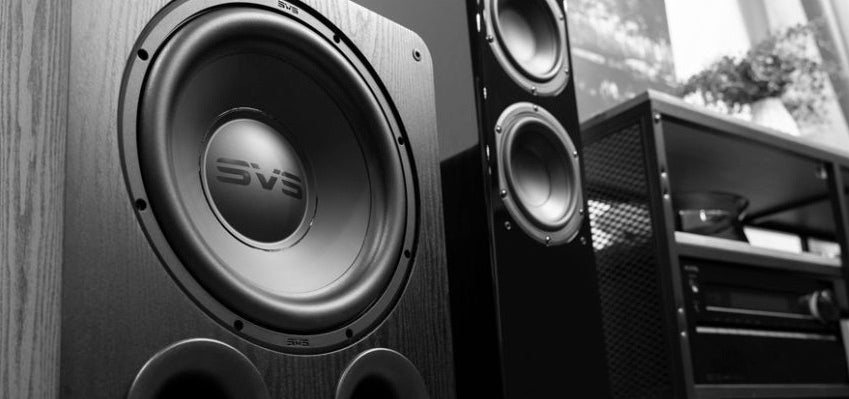Subwoofers: Doof Doof and So Much More
Yes, they go boom — but a great subwoofer is so much more than just cinematic thunder. At The Audio Experts, we believe subwoofers are the secret sauce in both hi-fi and home cinema setups. From delicate bass guitar lines to room-rattling explosions, they elevate every detail — if they’re done right.
Let’s dig deep into what makes a subwoofer truly special, the types you can buy, how to position them, and even how mixing sub types can create next-level results in your system.
🔊 Types of Subwoofers
There’s no “one sub to rule them all.” Different designs deliver different performance. Here’s a breakdown of the main types:
1. Sealed Subwoofers
Airtight and precise. Sealed subwoofers are all about speed and accuracy. They don’t move as much air as ported designs, but they’re tight, fast, and great for music lovers or smaller cinema rooms.
2. Ported Subwoofers
Also called bass reflex, ported subs use a tuned vent to move more air and deliver deeper bass — perfect for big rooms and earth-shaking cinema effects.
3. Bandpass Subwoofers
These use chambers around the driver to limit the frequency output and boost volume at a specific range. The result? Ultra-smooth bass that’s incredibly hard to localise.
Whatmough bandpass subs are a secret weapon in our custom installs — delivering “you feel it, not hear it” bass, especially in music-focused rooms.
4. Passive Radiator Subs
These use a driver and an unpowered “radiator” instead of a port. You get port-like bass without port noise, in smaller enclosures. We love these in slimline or design-conscious setups.
🎵 Music vs 🎬 Cinema: Subwoofer Use Cases
There’s a big difference between how subs are used for two-channel listening vs home theatre:
Music-First Systems
- Focus on speed and detail
- Sealed or bandpass designs excel here
- Integration is key — it shouldn’t steal the show
Cinema Subwoofers
- Big output, deep extension
- Ported or large-format sealed subs work best
- Think house-shaking rumbles and cinematic explosions
At TAE, we often recommend: SVS PB16-Ultra for deep, room-filling home cinema — paired with a sealed SVS SB-3000 to handle fast transients like gunfire or percussive hits. Yes, mixing types is controversial — but when done right, it's pure magic.
📡 Subwoofer Amplification Explained
Subwoofers need serious power to move large drivers and control bass response. Here's what to know:
- Class D amplification: Most modern subs use it. Efficient, compact, powerful.
- DSP (Digital Signal Processing): Helps tailor the sub’s output to the room — some models allow app-based tuning.
- Wattage isn’t everything: A 300W amp with great control can beat a boomy 1000W with poor design.
📐 Room Modes and Sub Placement (Geek Out Zone)
Bass waves behave very differently than mids or highs — they bounce, cancel, and resonate depending on your room size and shape. These are called room modes.
Calculating Room Modes
Room modes can be roughly estimated using the formula: f = 343 / (2 × d), where f is the modal frequency in Hz and d is the room dimension in metres.
Example: In a room 4 m long: f = 343 / (2 × 4) = 42.875 Hz. This is a frequency where the room may boost or cancel bass. Multiply across width, height, and diagonals to find other modes.
Managing Room Modes
- Move your subwoofer — even 30 cm can change response
- Use bass traps or acoustic panels to control ringing
- Multiple subwoofers can cancel out modal peaks/nulls
🎚️ Using Multiple Subwoofers
One sub is good. Two (or more) is better — when set up correctly.
Benefits of Multi-Sub Systems
- Smoother bass response across the room
- Less localisation (bass feels like it’s everywhere)
- More dynamic headroom
Mixing Types
We sometimes pair a large ported sub (like an SVS PB16-Ultra) for explosions and deep rumbles, with a smaller sealed sub (like an SB-3000) to take care of tighter, punchy sounds. Some purists say never mix — but our ears say otherwise.
Positioning Tips
- Try front corners first, then stagger them
- Avoid placing all subs on the same wall if possible
- Calibrate individually, then together (using an AV processor or room correction software)
🆚 Sealed vs Ported: Quick Comparison
| Feature | Sealed | Ported |
|---|---|---|
| Size | Compact | Larger |
| Output | Controlled, accurate | High SPL, deep extension |
| Music Suitability | Excellent | Good (can be boomy if not tuned) |
| Cinema Suitability | Good | Excellent |
| Integration Ease | Easier | Requires more tuning |
🎯 Subwoofers We Recommend
- SVS – PB16-Ultra, SB-3000, Micro 3000
- REL – Known for their high-speed, musical subwoofers, REL offers exceptional performance for both two-channel systems and home cinema setups. Whatmough – Bandpass subs with serious stealth
- Definitive Technology – Built-in amp subs with tight integration
- Velodyne – High-end, DSP-tuned bass masters
- JBL – Clean output and home cinema muscle
- JL Audio – Tight, musical subs with premium build
- Bowers & Wilkins – Beautifully integrated, refined low-end
🎉 Ready to Feel It?
Still unsure which sub is right for your system? Come into our showroom and feel the difference in one of our six custom cinema rooms or high-end two-channel setups.
We’ve got subwoofers you can’t hear — but you’ll feel them in your chest. 😎

